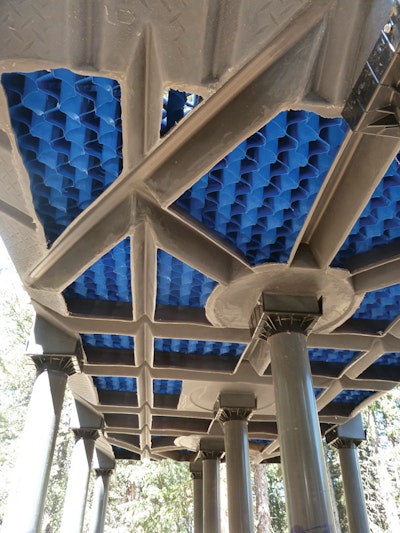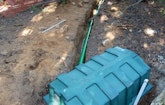
Interested in Repair?
Get Repair articles, news and videos right in your inbox! Sign up now.
Repair + Get AlertsEffluent running out of the observation port and ponding in the drainfield alerted the manager of Echo Lake Lodge in Idaho Springs, Colo., to a serious problem. The lodge has a full commercial kitchen, 45-seat restaurant, and gift shop.
The lodge owner, Denver Parks and Recreation, hired a pumper to clean the 2,000-gallon septic tank twice a week as officials searched for a solution. An employee at Denver Water recommended All Service Septic, an engineering/design firm in Arvada. “We don’t have soil here; we have primarily bedrock,” says co-owner Richard Petz, P.E. “The problem was high-strength waste discharging to a moderately over-excavated drainfield that couldn’t treat it.”
The lodge, located at 10,600 feet elevation on a mountain in the Arapaho National Forest, is open May through September and experiences frequent two- to three-hour power failures. The replacement system had to handle high-strength waste, intermittent heavy flows, require minimal maintenance, and start up immediately when the lodge opened in spring. “Our biggest challenge was holding the design below 2,000 gpd to keep the price affordable,” says Petz.
Petz chose a FAST (fixed activated sludge treatment) unit from Bio-Microbics. The only moving part in the aerobic, packed-bed bioreactor is an above-ground blower. Because the lodge manager wanted minimal interference with tourist traffic, installation began in September, with its genuine possibility of snow and no rescue by county plows.
Site conditions
Soils are highly weathered fractured metamorphic bedrock with a percolation rate of 10 to 30 minutes per inch. Echo Lake Park is on the National Register of Historic Places, and its pristine lake is renowned for fishing and wildlife.
System components
Petz designed the passive gravity system to handle 1,999 gpd with an average flow of 1,200 gpd. Major components are:
- 1,250-gallon two-compartment concrete grease interceptor, with tanks from Colorado Precast Concrete
- Existing 2,000-gallon two-compartment concrete septic tank
- 3,250-gallon two-compartment equalization tank with SaniTEE effluent filter
- 7,000-gallon tank with HighStrengthFAST 4.5 (4,500 gpd) treatment system (Bio-Microbics)
- 1,000-gallon tank with 3-inch automatic dosing siphon (Fluid Dynamic Siphons)
- 2,100-square-foot pipe-and-gravel drainfield
System operation
Laterals and lines connecting the tanks are SDR 35 4-inch PVC pipe. The kitchen lateral connects to the grease interceptor, then to the septic tank. The sanitary lateral plumbs to the septic tank.
Liquid flows from the septic tank to the equalization tank to the treatment tank, where air introduced from the blower at 90 to 140 cfm vigorously circulates effluent through the treatment zone’s channeled flow paths. Bacteria attached to the stationary media metabolize nutrients and provide nitrification/denitrification.
Treated odorless effluent flows to the dose tank, where the siphon converts small, continuous flows into large intermittent doses. When the siphon trips, 200 gallons discharge 220 feet through 3-inch pipe to a manifold that distributes the dose to three 4-inch laterals 100 feet long, 6 feet apart, and spaced 3 feet from the sides of the trench. Drilled 18 inches on center, the 3/8-inch orifices face down at 5 and 7 o’clock positions. Effluent is 30 mg/L BOD and TSS or less.
Installation
Project manager Kelly Smith of Roth Sheppard Architects in Denver oversaw the installation. Denver Parks and Recreation subcontracted Esco Construction Co. in Evergreen to install the tanks and drainfield. Co-owner Tim Petz and assistant Erik Hamilton from All Service Septic supplied and installed the treatment unit.
The first challenge was finding equipment that could navigate the winding mountain roads. Contractors staged the equipment in a small side parking lot. Installation began with the drainfield, as there was no opportunity to close the restaurant during the switch over. “As soon as we hooked up the tanks, the new system had to handle flow,” says Petz.
Denver Parks and Recreation marked trees to remove, then Esco cut and sawed them into firewood for the lodge. To meet the state’s required 4-foot separation from bedrock, the driver of the Komatsu trackhoe excavated a 100- by 21-foot-wide trench 8 feet deep at the head and 6 feet deep at the toe.
“The replacement drainfield was tricky because it was next to and down gradient from the old one,” says Petz. “They were cutting into and working on the side of a mountain with a 20-percent slope.”
As Esco excavated the highly weathered bedrock, it broke into granular material, which was stockpiled and used for filter material. “Having this source saved about $50,000 in septic sand,” says Petz. Esco bedded the excavation with 4 feet of it, added 12 inches of gravel, laid the three laterals, and covered the drainfield with geotextile to prevent soil from washing into the gravel. They backfilled to grade with native topsoil.
After the pumper serviced the septic tank, Esco tested it for watertightness and it passed. Meanwhile, workers removed the restaurant’s two small grease interceptors and installed the new tank. Petz added another baffle to increase retention time and pull more grease out of solution.
“We had considered metering the highly variable flows, but decided against such pumps because of the remoteness,” he says. “So, we added extra tankage to accommodate the flows.”
To set the tanks, Esco hired a crane, which barely made it up the mountain. A semi-tractor truck shortened to navigate the turns brought the treatment unit. Tim Petz and assistant, Erik Hamilton, screwed and glued the 20-inch-long legs to the bottom of the unit as the backhoe suspended it.
“We attached the exterior legs first, then set the tank on the ground with the backhoe still supporting it and attached the inner legs,” says Petz. Assembling the treatment kit took four hours.
Then they assembled the blower and located it 30 feet from the tank. If the area experiences extended blackouts, a generator at the lodge will power the blower. After the system passed its final inspection, Esco activated it. Tourists at the lodge were unaware of the switchover.
Maintenance
All Service Septic holds the two-year service contract. Each September, Petz monitors the sludge in the tanks with a Sludge Judge and makes sure the blower action in the treatment zone looks appropriate. He cleans the bug screen on the blower, checks the liquid level in the dosing tank to guarantee the siphon is working, and looks for excessive moisture in the drainfield.









